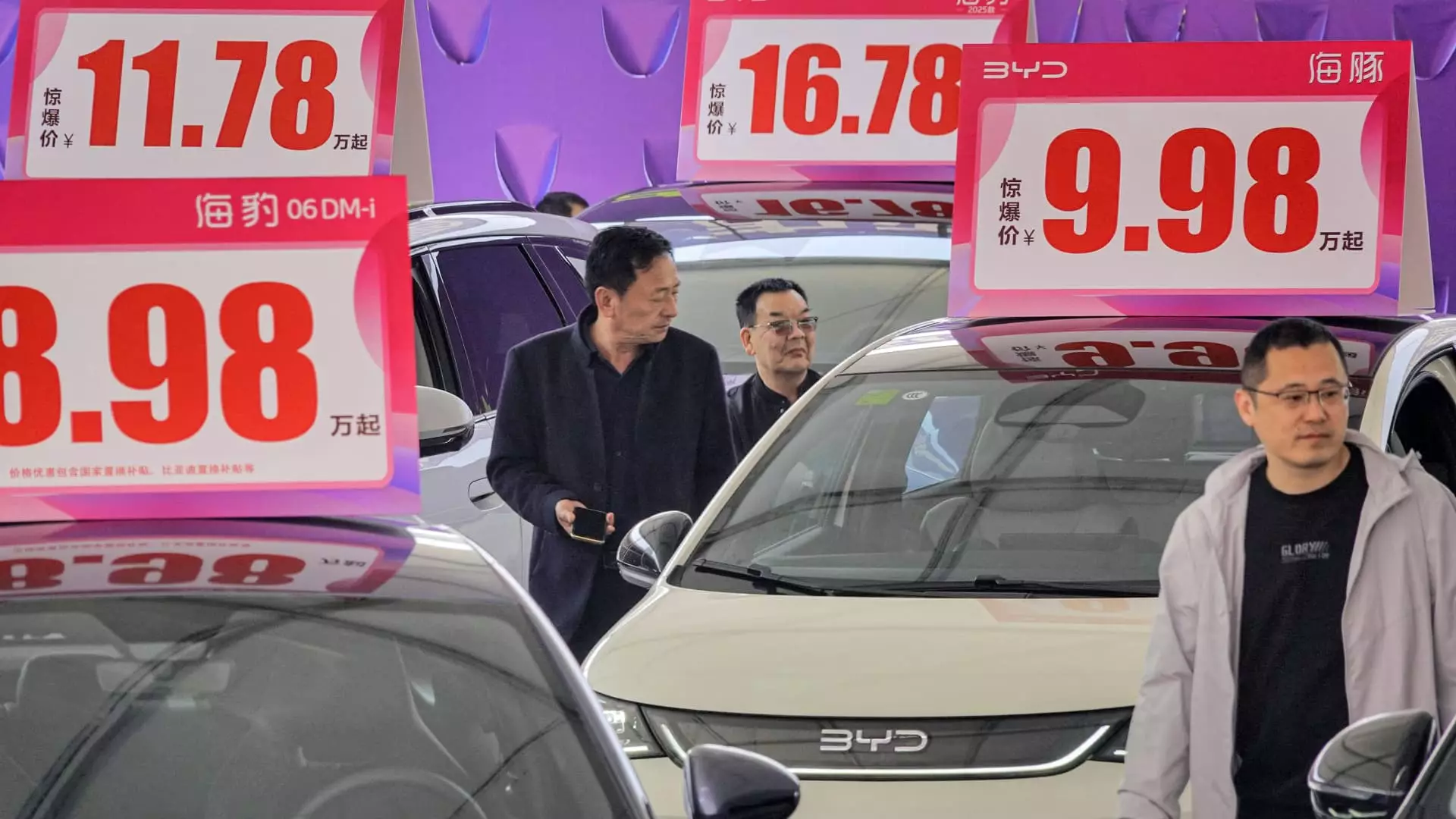The rapidly evolving landscape of China’s electric vehicle (EV) market is undergoing seismic shifts, and at the epicenter of this transformation is BYD, the industry titan. Recently, BYD initiated a suite of price cuts that have sent shockwaves through the automotive sector. Discounts soaring as high as 30% on various lower-end battery and hybrid models, including the inexpensive Seagull now retailing at a mere 55,800 yuan ($7,750), highlight a cutthroat competition that threatens industry stability. Critics argue that BYD’s approach not only jeopardizes the financial viability of smaller automakers but also feeds a dangerous cycle of deflation that risks making the Chinese EV industry a mere battleground for survival rather than a landscape for innovation.
Analysts have cautioned against the broader repercussions of such aggressive pricing strategies, describing the industry’s current state as one of “large shock.” Zhong Shi, an analyst from the China Automobile Dealers Association, articulated a palpable sense of anxiety among competitors, particularly those unable to match BYD’s price cuts. This atmosphere of fear reflects a deeper malaise within a sector that had, until recently, served as a beacon of economic promise in a Chinese economy suffering from sluggish growth and dwindling consumer confidence. The implications of BYD’s pricing war extend far beyond immediate profits; it could dilute the focus on quality and innovation, pushing the industry towards a dangerous ‘race to the bottom.’
Governmental Impact and Consumer Behavior
In light of BYD’s maneuvers, one must scrutinize the role of government policy in shaping this environment. While state initiatives aimed at encouraging consumption, particularly subsidies for new energy vehicles, initially seemed beneficial, they may have inadvertently paved the way for fierce price wars. Robin Xing, Morgan Stanley’s Chief China Economist, posited that the persistent imbalance between supply and demand is indicative of a deeper systemic issue—one where the forces driving deflation appear to be gaining precedence over the much-vaunted rebalancing towards more sustainable consumption-driven models.
The government’s push towards electric vehicles has translated into a short-lived boom that, paradoxically, may be undercutting long-term health. The fallout from such misguided policymaking deserves serious examination, as it may well stifle growth opportunities for significant segments of the industry, limiting the market primarily to those giants like BYD, while sidelining innovative newcomers and niche manufacturers. In the end, consumers may reap short-term benefits in the form of lower prices, but at what expense to the diversity and richness of options available in the market?
Fears of an ‘Evergrande’ Scenario
Concerns surrounding the existential risks facing the EV sector were echoed recently by Wei Jianjun, Chairman of Great Wall Motors, who ominously compared the current trajectory of electric vehicles to the unsustainable real estate bubble represented by Evergrande. His argument merits scrutiny, suggesting that the auto industry’s frenetic growth, buoyed largely by government intervention, may be masking underlying vulnerabilities. Just as the real estate sector eventually collapsed under the weight of its own excesses and inflated expectations, could the EV market succumb to similar pressures?
The specter of excessive leverage looms large in this landscape, as many automakers, particularly emerging enterprises, may find themselves entrapped by debt and incapable of weathering the maelstrom of price wars. The various price cuts across the industry, averaging declines of between 18% and 27% over the past two years, certainly provide immediate allure for the consumer. Still, they raise red flags regarding sustainability and profitability. If these companies cannot maintain financial health amidst this tumult, consumers may ultimately be left with fewer choices in the long run, should the weaker players exit the market, driven by unmanageable pressures.
A Global Perspective and Geopolitical Tensions
The reverberations of China’s aggressive pricing strategies are far-reaching, extending beyond its borders and impacting global markets. Recently, the European Union reacted to the surge of competitively priced electric vehicles from China by imposing tariffs on imports, signaling a defensive posture aimed at protecting local industries. The U.S. has followed suit, instituting hefty duties as well, effectively sealing the door on Chinese EVs in its market. The unwillingness of these Western economies to embrace China’s burgeoning EV sector lays bare a growing apprehension about the dominance of subsidized products capable of outpricing their competitors.
This geopolitical tension, accentuated by trade restrictions, compounds the challenges facing both Chinese manufacturers and their competitors abroad. While BYD’s recent achievement of outselling Tesla in Europe presents an apparent victory, it simultaneously ignites fears of retaliatory measures aimed at curbing China’s automotive ascendancy. The narrative surrounding the electric vehicle revolution must be reframed from one of unqualified growth and opportunity to one of strategic navigation through a minefield of competitive pressures and protectionist measures.
As the world’s second-largest auto market grapples with the complexities of a burgeoning EV sector, it’s essential to dissect not just the immediate implications of price wars but also the longer-term ramifications for innovation, stability, and global competition.

